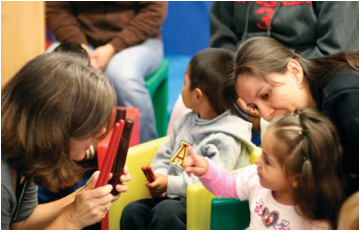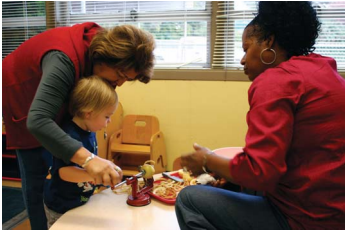76 15.3: Hate is Learned and Can Be “Unlearned”
Prejudice and discrimination persist in society due to social learning and conformity to social norms of the dominant race, which is white. Children learn prejudiced attitudes and beliefs from society: their families, teachers, friends, the media, and other sources of socialization.
It is important to note that hate can begin at an early age. As professionals in the early care field we must work to educate and eradicate the negative ideas and behaviors that stem from it. No child is born with prejudice. They are born wanting to connect with others. Just as love is learned when children are cherished and nurtured, hate is learned by the messages that are both verbal and nonverbal. As hate is learned, so it can be unlearned. According to the Anti-Defamation League, leading experts on child development argue that the problem begins early. [240] Infants and toddlers are keen observers of difference and when those differences are not supported, it can lead to fear, which can lead to hate if not nurtured appropriately. By preschool age, children have already learned stereotypes or acquired negative attitudes toward “others:” The process of countering those negatives with positives must also begin at an early age.
In an article by Caryl Stern, “Talking to Young Children about Bias and Prejudice,” Stern states, “Louise Derman-Sparks, an expert in the field of early care and education, points to three major issues that are important to keep in mind when talking to children about prejudice and discrimination.
- Children are not colorblind
It is a myth that young children don’t notice people’s differences, especially skin color. Children are in fact acutely aware of our shadings and gradations, and they need matter-of-fact, simple, and truthful explanations of these differences. At an early age they may ask for explanations. It is important for families to be equipped to respond.
- Talking about differences does not increase prejudice in children
Being aware of differences is not the same as avoiding, ridiculing, or fearing specific differences. Moreover, awareness does not lead to negative attitudes. Children learn biases from important adults in their lives, from the media, from books and from peers. Families need to talk to their kids-to give them accurate information and to reinforce when their behaviors indicate a value of differences as opposed to a prejudice. Surprisingly, many adults have trouble opening up and broaching the subject. For these adults, it’s a good idea to practice the discussion with an adult before taking it up with children. Above all, families should ensure their words of wisdom are in tune with their actions. Sending a contradictory message only reinforces prejudices and stereotypes.
- It is not enough to talk about similarities among people
While we want our children to understand the things that bind us as human beings, it is equally important that they understand that shared characteristics, language and customs are expressed in different ways. When we continuously tell our children, “See, they do that just like us;’ we may be implying that similarities are the only things that make “those” people acceptable.
- Talking to Children About Diversity: Preschool Years
A child’s age is one of the most important factors in considering how to begin a discussion on any subject dealing with prejudice, discrimination or, more simply, the things that make people different. The most important thing to keep in mind is that it is never too early, or too late, to talk to children about respecting diversity.”
We must prepare ourselves to respond to acts of bias, even if they are unintentional. Children will carefully observe how the adults in their lives intervene when someone is the target of hurtful or discriminatory behavior. Silence in the face of injustice conveys the impression that adults condone the behavior or consider it not worthy of attention. We must make it clear to our children that name-calling will not be tolerated and explain the thinking behind “zero tolerance” when it comes to prejudice.” [241]

Learning Accurate Information
Learning accurate information about cultures different from your own requires persistence, dedication, openness, and honesty. Exploring your own values, beliefs, and traditions—and learning how they impact you and the way you engage with the world—are preliminary steps to be taken before understanding others. In taking such steps, you also become more aware of your own stereotypes, assumptions, and biases (Sue 1998). There are many ways to pursue a higher level of self-awareness and reflect on your experiences and the cultural lens through which you view the world.
Gaining Knowledge
Increasing your cultural knowledge is essential. Families are rich sources of information for learning about their cultures. It is important to engage in meaningful conversations with families. Key skills that are important to possess include the ability to listen to others who are culturally different, to actively learn about their experiences, and to respect differences in a nonjudgmental way (Derman Sparks 1995).

There are many ways to learn about different groups of people. Reading information about a cultural group is one way (Phillips 1995), inquiring and learning about the various home practices of families (Gonzalez Mena 1995) is yet another. It is equally important to seek out educational and multicultural training experiences (Derman Sparks 1995). In addition, learning how culture can be integrated into the curriculum and classroom environment is essential (Derman Sparks 1995). [244]

